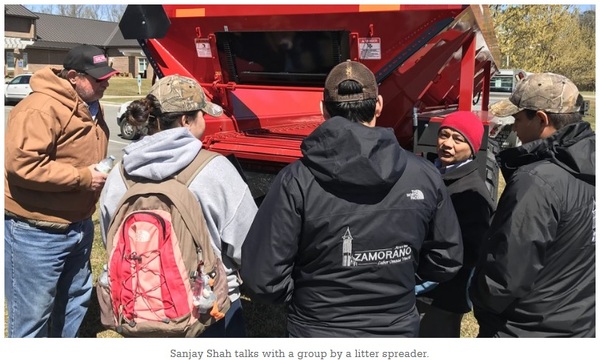Extension ASAs and NC State Faculty Give Calibration Demos
Published: April 24, 2019
Source : https://cals.ncsu.edu/prestage-department-of-poultry-science/news/field-notes-extension-asas-and-faculty-give-calibration-demos/
By Rhea Hebert
NC State Prestage Department of Poultry Science
If you aren’t an active farmer, you might think spring has just finally sprung – but for North Carolina farmers, spring chores start before the scarves come off. For poultry farmers, one chore is spreading poultry litter as fertilizer. To help the farmers get it just right, NC State Extension lends a hand with calibration demos.
While many PDPS faculty have Extension appointments (some are 100% Extension) they don’t work alone. There are four poultry Area Specialized Agents (ASAs) who serve all 100 N.C. counties and the Qualla Boundary of the Eastern Band of Cherokee Indians: Dan Campeau, Richard Goforth, Lauren Greene and Margaret Ross.
Part of that service involves training farmers how to calibrate specialty equipment. Why is calibration important? Simple: it protects the environment and saves money.
Our poultry ASAs work directly in their regions to help farmers plan and implement good policies. One such policy involves litter management. “Clean shavings are put into a house before a flock and then litter is those shavings plus poultry manure, which makes for an excellent fertilizer,” explains Ross. It can be used in hay fields and for various crops, including corn, wheat and soybeans.
That litter, though it’s technically waste, doesn’t go to waste. Not with a good plan in place.
Planning what to do with litter is important. But moving, managing and spreading litter takes expertise. That’s where poultry ASAs come in.
Each spring, the ASAs hold calibration demos in their areas so farmers know that their equipment is doing its best work. A litter spreader is pulled behind a tracker or truck to put litter on a field.

Without routine calibration, it may not apply at agronomic (proper) rates for the field’s crop. Just like any machine, it should be tested regularly to make sure it’s working properly.
In collaboration with Sanjay Shah, a professor in the Department of Biological and Agricultural Engineering, Ross, Goforth, Campeau and Greene bring farmers together to learn how to get their litter spreaders ready for a new season.
When a spreader is working well, litter goes on a field evenly. When it isn’t, litter is uneven, either wasting the fertilizer or under-feeding the soil. The goal is good coverage. So how does a farmer know before they start spreading?
It starts with buckets.

The ASAs help Shah position buckets to catch litter from the demo truck. If one bucket overflows or stays empty, the spread is uneven. It’s time to tune up and re-test until the spread is behaving as expected.
In addition to demos, farmers heard from the ASAs and Extension faculty, learning what they need to start their season off right.
Next up for our ASAs? More demos, focused on poultry processing. Find more events, support and information on our Extension site.
Photos Margaret Ross
Source
https://cals.ncsu.edu/prestage-department-of-poultry-science/news/field-notes-extension-asas-and-faculty-give-calibration-demos/Related topics:
Mentioned in this news release:
North Carolina State University - NCSU
Recommend
Comment
Share

Would you like to discuss another topic? Create a new post to engage with experts in the community.








.jpg&w=3840&q=75)